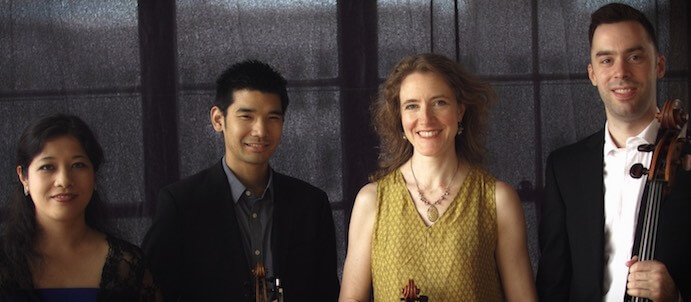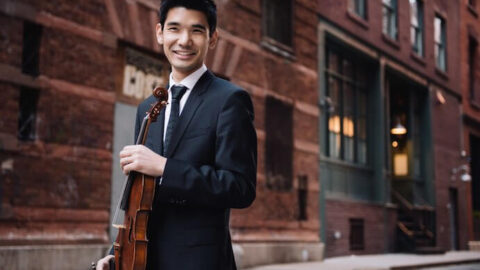Alex Shiozaki is the new violinist with the Momenta Quartet. On September 28-October 2, 2016 at the Tenri Cultural Institute of New York, the ensemble will present Momenta Festival II. This year’s festival features four distinctive programs, each curated by a different member of the ensemble. We asked 5 questions to Alex about joining the Momenta Quartet and his experience partially-curating Momenta Festival II.
What is it like to be the newest addition to the acclaimed Momenta Quartet? Did you have a prior connection to them?
I’m still pinching myself! It’s unbelievable, not just to be playing with such an amazing group of musicians, but to feel like I can fit so easily into their sound. I’ve always thought of the idea of a string quartet as barely short of miraculous: four individual artists, each with their own musical ideas, somehow coming together and creating a cohesive performance. And yet, here I am! The first few months with the quartet left me short of breath, as I had to learn what seemed to be a different concert program every other week. The summer break has given me some time to settle in, however, and I’ve been able to take a step back and realize how lucky I am to have found a group that fits my own musical sensibilities so well.
I first met Momenta four years ago, as part of the Chelsea Music Festival in New York. Coincidentally, they were just wrapping up their previous violin search, and I remember feeling a twinge of regret that I had missed an opportunity to try out for the quartet. Fast forward three years, and I found myself on an Argento Ensemble tour with Stephanie, who actually had recommended me for the gig. On that trip, we bonded not just through the music, but also through conversing about our chamber music experiences. We ended up next to each other on the flight back to NYC, and talked nonstop for the duration of the flight. At the time, joining the group was the last thing on my mind; one does not realistically hope to join a quartet that already has four members and no gray hairs.
A few months later, Stephanie asked if I’d be interested in a try-out with the group. What an incredible rush, to receive that email! I ran out of the bedroom, waving the phone at Nana (my wife and duo partner.) Even though I knew I shouldn’t get too excited–and kept phrasing it to both Nana and myself as “a great opportunity, even if it doesn’t work out”–I felt that it would work out. And from my first trial rehearsal with Momenta, I knew that it would.

I am curious about your relationship to the music of contemporary Japanese composers. What can listeners who are unfamiliar with the music of Japan brought to be more aware of, and how do you channel this when playing it?
One of the most important concepts in all forms of Japanese art is ma, or negative space. Ma is an acknowledgment of the gap between structural elements. In music, this space can be the silence between musical phrases or the sustained sound between the beginning and ends of notes. Often Japanese music will explore a single pitch for an extended amount of time, inviting the audience to hear the subtle changes in a non-static tone. To the uninitiated, such music may be dismissed as slow and simple, and indeed many contemporary Japanese pieces come with relatively slow metronome indications. The most rewarding way to experience these sounds for the first time is to simply listen to each moment, forgetting about Western musical ideas such as “journey” or “destination.”
I myself became familiar with ma through playing the music of Somei Satoh. I had actually not paid much attention to my own sound quality during my undergraduate years, a shortcoming pointed out by my teacher Ron Copes when I arrived at Juilliard. Timbre and vibrato is one of the most important musical aspects of Satoh’s Birds in warped time II, which I’ll be playing on September 29th as a part of my first curated Momenta Festival program. I must give Satoh a lot of credit for igniting my self-interest in sound quality; these days, whether playing Japanese or Western works, I try to focus on keeping the “between” sounds alive, through changing bow speed, pressure, contact point, or vibrato. Though especially applicable to Japanese music, this idea works in all musics, whenever a note is sustained. In fact, these approaches served me extremely well when I performed with Stars of the Lid, an ambient drone-music duo—pretty far from my traditional repertoire!
How do you find the process of putting together a festival with Momenta Quartet, in addition to preparing for performance ?
In preparing for Momenta Festival II, I’m greatly indebted to the rest of the quartet’s experience, as they were all part of last year’s inaugural Momenta Festival. While there is a lot of work involved in self-producing a four-day festival, they already have internalized the mental checklist of what needs to be planned: venue, dates, format, funding, publicity, programs, and our tremendous roster of guest artists—for Momenta Festival II, we’ll be joined by the soprano Tony Arnold, pianist Vicky Chow, experimental vocalist Ubiet from Indonesia. And, of course, my wife / duo partner, pianist Nana Shi.
Some of this was already in place by the time I came on board, and the rest is coming together quite smoothly. The one thing that is my sole responsibility is the curation of my own program, which will be the second of the four nights (September 29th). After cycling through several programming ideas, I settled on a theme that represents my own musical identity: contemporary Japanese music, paired with Beethoven’s Op. 135 quartet!

Where do you locate ‘authenticity’ in new works that you are performing together as a quartet?
Authenticity! The bane of us performers’ existence.
Actually, part of the reason I find the performance of contemporary music less problematic is that there is no need to argue about historical instruments, tuning, centuries-old treatises, or decades of performing traditions. One can simply grapple with the music on its own terms. I suppose authenticity may be found in communication with the composer, but I also find this to be a double-edged sword. There is an appropriate balance between the composer’s vision and the performer’s interpretation, and I feel most comfortable when there has been a little bit of give-and-take between the composer and performer. Too many demands, and we performers have no ownership over a performance. Too much freedom from the composer, and I’m afraid that he or she simply hasn’t shared their vision with us. Finding the right balance is key.
What, to you, was a valuable piece of advice that a mentor, elder, or colleague passed along?
“If you’re not improving, you’re getting worse.” Though I’m sure countless mentors have bestowed these words unto their pupils, I happened to receive this bit of wisdom from the pianist and musicologist Robert Levin. Here was a man who could do seemingly anything at the piano–perform Mozart concerti, improvise cadenzas, demonstrate passages from any piece of music at will and from memory–stating that his daily goal was to surpass himself as a musician. Especially after having graduated out of weekly lessons, this has been an important source of motivation for me. Every day I try to be a little bit better than the day before, and a day not spent improving—a day off from violin—is one that nags at me as I sleep.
























